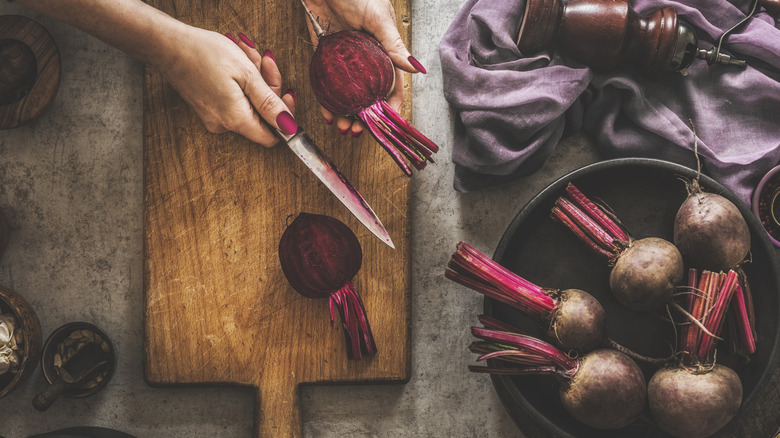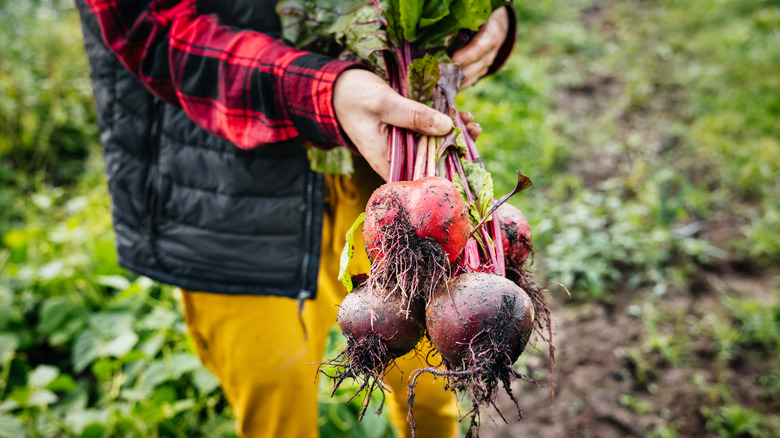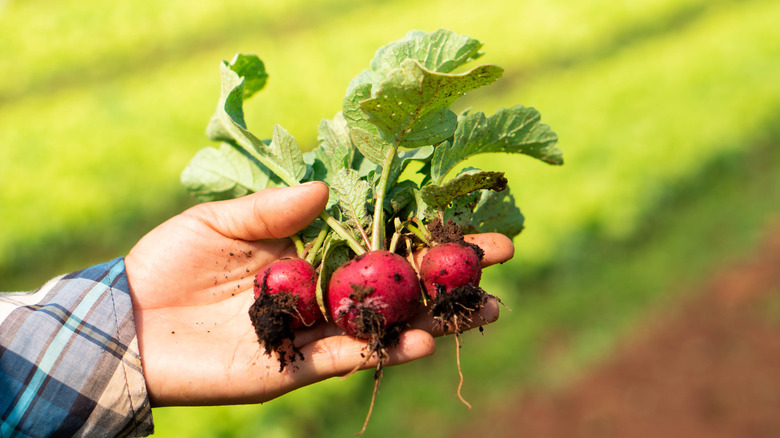For Bigger Beets, These Are The Varieties You Should Grow In Your Garden
Pulling a huge baseball-sized beet (Beta vulgaris) from the earth is one of the most satisfying moments in gardening. Unfortunately, many backyard gardeners settle for a less-than-stellar harvest — although there are some miniature veggies you can grow in your backyard that can be rewarding. This frequent disappointment can still happen despite all the right care, like using good soil, regular weeding, plenty of sunlight, and consistent watering. The reason is that most standard beet varieties are simply not bred for the size, consistency, and quantity home gardeners and cooks crave. If your goal is to regularly harvest beets that are perfect for roasting, amazing to look at, and wonderfully tender to eat, then choose one of these varieties: the Detroit Dark Red, the Crosby Egyptian, the Crimson King, the Lutz Green Leaf, or the Mangelwurzel.
Growing bigger beets does not require any fancy techniques or special tools; it only requires you to swap out your generic beet seeds for one of those proven performers. In fact, beets are one of the best vegetables to grow if you're a lazy gardener. Fortunately, these five heirloom and specialty varieties reliably deliver large-sized produce with superior flavor and texture. They are also great choices overall since they ensure your harvest will be not just plentiful but high-quality. So say goodbye to underwhelming yields, and prepare to fill your baskets with a beet harvest that will taste as amazing as it looks.
The five varieties for superior size
Selecting the right variety is the simplest and fastest path to a larger harvest. Begin with the Detroit Dark Red. This classic variety is known for its uniform, globe-shaped roots that reliably reach a medium-large size while maintaining a rich, deep-red color that's great for canning. You can also consider the Crosby Egyptian, which offers super-fast growth and a neat flattened-globe shape that provides excellent girth quickly. This is a good option if you have a small garden and need a fast turnover.
If you're looking for the most consistent results, the Crimson King stands out with its medium to large roots and delicious flavor. Gardeners who value versatility may prefer the Lutz Green Leaf. This variety offers two great perks: baseball-sized roots and abundant, edible greens that are a fantastic bonus harvest. It is also known as the "Winter Keeper," as it boasts great storage qualities that make it a keeper for colder months.
Finally, for a fun showpiece, try the Mangelwurzel. This outlier grows a huge cylindrical root and is the largest on our list. While it takes up the most space, it is a rewarding experiment for those wanting beets with a truly impressive size. Beets grow in USDA hardiness zones 2 through 11, making them suitable for nearly all U.S. regions.
Simple steps to ensure that bigger harvest
Even with the best seeds, maximum size and harvest will require some effort on your part, and you will need to avoid some common beet growing mistakes. The most important step is aggressive thinning. Every beet seed you plant is actually a cluster of tiny seeds, which can cause severe overcrowding if left unchecked. You will need to thin your seedlings early on; perform the first thinning when the plants are just an inch high, and pull them to leave one plant every one to two inches. As they grow, thin them a second time, leaving only the strongest plant every three to four inches. Adequate spacing is important for big roots, and overcrowding breeds small beets.
The second key to success is providing consistent moisture. As beets grow, their demand for water increases, and environmental stress, like a sudden dry-wet cycle, can cause the roots to split or develop a tough, woody texture. Keep the soil evenly moist, especially when the roots are actively growing in late summer. Add a light layer of straw or grass clipping mulch to help regulate soil temperature and conserve moisture. Follow any seed packet instructions for fertilizer or pesticides if needed. Remember, most of these larger varieties may need a little extra time – 50 to 70 days total – to achieve their fantastic full potential, so exercise patience and care for a delicious reward.


